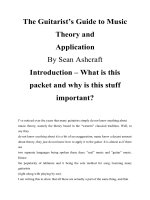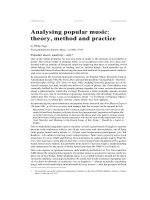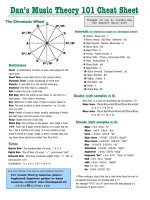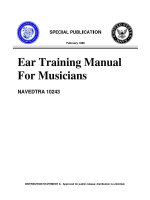Music Theory FundamentalsSection 1.3 potx
Bạn đang xem bản rút gọn của tài liệu. Xem và tải ngay bản đầy đủ của tài liệu tại đây (131.52 KB, 2 trang )
LearnMusicTheory.net High-Yield Music Theory, Vol. 1: Music Theory Fundamentals
12
Section 1.3
A LL A B O U T O C T A V E S
An octave is the distance from a note up or down to the next note with the
same name. For example, from the pitch A up to the next A is one octave.
Octaves span eight letter names: A-B-C-D-E-F-G-A = 1-2-3-4-5-6-7-8.
Middle C is the C just to the left of center on the piano keyboard; it is near
the “middle” of the piano. In treble clef, middle C is one ledger line below
the staff. In bass clef, middle C is one ledger line above the staff. On C clefs,
including alto clef and tenor clef, middle C is at the center of the clef sign.
All of the notes below represent exactly the same piano key (middle C).
In a grand staff, middle C is notated differently depending on whether it is
in the treble or bass clef. Middle C is literally the “middle” ledger line, one
line below the treble clef and one line above the bass clef.
Ledger lines may occur between the staves to make it clear whether the
notes are in the treble clef (or right hand) part or bass clef (left hand) part.
&
middle C
B
middle C
_ _ _ _ _
_ _ _ _ _
_ _ _
_ _ _ _ _ _
_ _ _
B
middle C
?
middle C
w
w
w
w
&
middle C
?
w
w
&
middle C
melody in treble clef staff
=
= same pitches
in bass clef staff
&
? ?
middle C
w
w
w
w
w
w
w
w
Octave
Middle C
Middle C on the
grand staff
Ledger lines
between the
staves
Chapter 1: Music Notation
13
In American Standard (or Scientific) Pitch Notation, The octaves are
numbered, with middle C being C4. Every C begins a new octave number,
so the B just below C4 is B3, and the D just above C4 is D4. Accidentals
don’t change the octave; B#4 = C5, and Cb5=B4.
Helmholtz pitch notation is used widely in Europe and older science
publications. Middle C is c’ (read “one-line C”). Octaves are C,, (“subcontra
C”); C, (“contra C”); C (“great C”); c (“small C”); c’ (“one-line C”=Middle
C); c’’ (“two-line C”); c’’’ (“three-line C”); and c’’’’ (“four-line C”).
The ottava symbol (8va) raises a note by one octave, while the ottava bassa
(8vb) lowers a note by one octave. Ottava always appears above the staff,
and ottava bassa appears below the staff. Similarly, quindicesima (15ma)
raises a note two octaves; quindicesima bassa lowers a note two octaves.
The octave clef lowers the music an octave; it is often used for tenor voice.
&
middle C
?
C1 C2 C3 C4
(C4)
C5 C6 C7
w
w
w
w
w
w
w
w
&
”
“
ottava:
=
=8ve up
&
ottava bassa:
?
‘
“
=
=8ve down
?
w
w
w
w
&
ÿ
◊
quindicesima:
=
=two 8ves up
&
quindicesima bassa:
?
Ÿ
◊
=
=two 8ves down
?
w
w
w
w
&
‹
octave clef
=
&
treble clef
w
w
American
Standard octave
designations
Helmholtz octave
designations
Ottava
Quindicesima
Octave clef









